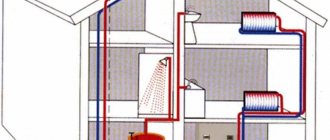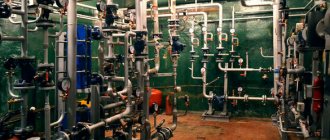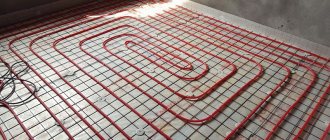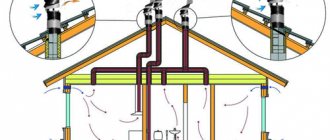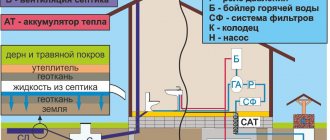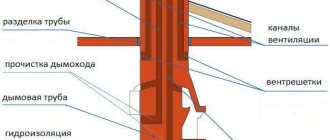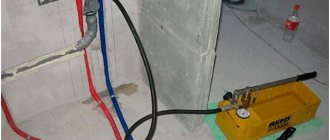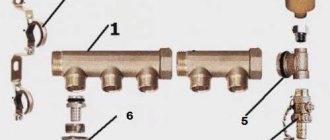When the construction of private buildings is at the design stage, selecting the optimal heat supply method is much easier. The area of construction, number of floors, and planned insulation are taken into account. No less significant are other characteristics and factors that are beneficial after the calculation of heat loss is completed. Many people today want to make heating without radiators. And today there are many alternatives. Let's take a look at them.
Installation of a heated floor system
If you decide to avoid installing radiators inside the building, there are several alternative heating methods:
- air systems;
- water heating,
- use of convectors;
- heating using a pipeline device.
How to make home heating from pipes instead of radiators?
Sometimes instead of radiators in the water heating system of a house, cottage, garage or greenhouse, steel pipes with a diameter of 60-100 mm are used.
At the same time, the length of the pipes must be large enough to provide the necessary heat transfer surface for such homemade radiators, since the ribbed surface of standard radiators transfers heat from the system much more efficiently. In principle, there is no big difference in installing a heating system with standard radiators and pipes. Such a system can be with natural, forced or combined circulation. Read more about water heating.
Fig. 1 Using pipes instead of radiators in a heating system with natural circulation: 1 – heating boiler; 2 – radiator pipes; 3 – expansion tank; 4 – jumper.
The pipes, which in this case act as radiators, are usually installed horizontally or with a slight slope towards the movement of the coolant (which is preferable) and are connected in series with a jumper (or jumpers - if there are more than two pipes). The diameter of the jumper is usually smaller than the diameter of the radiator pipes and must correspond to the diameter of the supply pipes.
Heating with pipes
When arranging heating systems for country cottages, pipes are rarely used. It is required that their length be impressive, and their diameter reach 60-100 mm (sometimes even more). This will provide the necessary heat transfer flow. Now this system looks very absurd, but there is heating without radiators.
If you decide to lay a pipeline instead of radiators, you must:
- heating boiler;
- pipes;
- expansion tank;
- jumper.
The pipes are installed horizontally. The jumper serves as a connecting element. Its diameter should be less than the diameter of the pipe.
Which pipes and radiator are better in the heating system of a private house?
From the wording of the question it is not entirely clear whether the private house is yours or belongs to the customer...
If we assume that the house belongs to the customer of the work, then in order to avoid claims on his part, everything should be done in accordance with the project (contract).
If you equip your home with a heating system, then its elements should be chosen taking into account durability and ease of maintenance, naturally taking into account the “price of the issue” available to you personally. Usually everything works out when the work is carried out according to a ready-made project that suits everyone.
Now, in order. And so the pipes:
“...which pipes to choose: steel or ferrous metal?” There are only two types of ferrous metal - steel and cast iron. Cast iron differs from steel only in the percentage of carbon in the alloy and usually in the presence of certain alloying additives. Pipes for heat, water and gas supply systems previously (in the last century) were produced only from steel of various grades. This was due to their relatively low cost and the ability to quickly install systems. However, this is where the advantages of steel pipes ended. The main disadvantage of steel pipes is their poor resistance to corrosion and, as a result, low durability. Therefore, if you want to leave a legacy of a reliably operating heating system, then I do not recommend using ferrous metal pipes.
Currently, polymer and metal-polymer pipes are produced for use in heat-water-gas supply systems. Their structural difference is the reinforcing layer. Some use fiberglass, others use metal (usually aluminum).
Their main advantage is the impossibility of recycling the material under natural conditions. It is this quality that determines their exceptionally high resistance to corrosion destruction. In addition, polymer pipes have many other advantages over steel ones. When operated under certified conditions, the service life of polymer pipes is at least 50 years.
In accordance with modern design standards, pipelines of all systems must be laid covertly. In interior design, pipelines of engineering systems are not used. Pipelines of engineering systems are fixed to elements of load-bearing structures of buildings, in specially equipped channels, behind decorative lining. As a last resort, pipes are laid in special plastic boxes.
And now about: “which radiator is better to buy for a private house, the area of the house is approximately 60 square meters?”
Let me assume that you need a heating device for your home, and not a source of thermal energy. If this is the case, then it is usually chosen according to two parameters - the required power and as an element of the interior of the room, naturally, based on financial capabilities. The power of a heating device for a “regular” living space made of stone-reinforced concrete structures with “standard” thermal insulation is selected at the rate of 1 kW per 10 sq.m. area. But it is far from a fact that the temperature in the room after such a “selection” will be comfortable. Typically, one heating device is installed in each room. In large rooms and taking into account the requirements of space-planning solutions, several heating devices can be installed. If a decision is made to use radiators of standard designs as heating devices, then most likely they will need to be covered with decorative grilles, which will inevitably reduce their efficiency.
Today, in terms of design and technical characteristics, the most efficient heating device is the fan coil. None of the radiators can compare with it in terms of operating efficiency and heat transfer.
Fan coil units are currently produced in a fairly large number of models, differing significantly in a number of capacities and appearance. All of them fit easily and naturally into any interior.
That’s basically all about which pipes and radiator are better in the heating system of a private house...
If you have any questions, I will answer them in personal correspondence. Good luck!
Heating a private house without radiators. What are the options?
When the construction of private buildings is at the design stage, selecting the optimal heat supply method is much easier. The area of construction, number of floors, and planned insulation are taken into account. No less significant are other characteristics and factors that are beneficial after the calculation of heat loss is completed. Many people today want to make heating without radiators. And today there are many alternatives. Let's take a look at them.
If you decide to avoid installing radiators inside the building, there are several alternative heating methods:
- air systems;
- water heating,
- use of convectors;
- heating using a pipeline device.
Air systems
The above type of heating may appear:
- single heater,
- the whole complex.
The complex provides the availability of heat sources and air ducts.
This is due to the maintenance and prompt provision of an increase in temperature, which can be ensured by this technique.
The presented type of heat supply is widespread:
- household sector (residential apartments, dachas, mansions),
- industry (warehouses, factory buildings).
The direct heat distributor is a pump with an internal hydraulic unit or a gas generator.
The device produces a specific amount of warm air required to heat the building, as a result of which it is distributed through a network of air ducts. It is supplied to the territory through air distribution devices. Thus, thermal saturation of the space occurs.
The following positive characteristics of the method can be identified:
- Convenient indoor temperature regulator.
- Lack of necessary installation near the windows of heating devices (as a result, heating will be without batteries) . The room looks harmonious from an aesthetic point of view. In addition, there is wide scope for implementing all kinds of designer solutions.
- Such a system supplies heat to the rooms in winter; In the summer it works like an air conditioner - for cooling.
But this principle of heat supply has a number of flaws:
- If the source of heat is a gas generator, then a significant minus is the cost of the energy resource . This fact guarantees an increase in operating costs of the system.
- The need to heat a home will require a significant amount of air. This entails the need to install large-sized air ducts that are sewn into the space under the ceiling. The situation turns out to be that the ceiling level has to be lowered to a certain height.
- Classic heat supply is considered the most optimal, when it is cool at the top and warm at the bottom. The air heating system is designed in the opposite way - the space above is perfectly warmed up, while the space below is in cold conditions. The way out of the situation is to organize a supply of warm air from the floor. Proper implementation of the system’s activities achieves the required climatic conditions.
- Reduced inertia leading to rapid cooling of the space. The reason is the instantaneous shutdown of devices.
It is rational to use air heating inside residential premises, where the heat source is a pump. It is irrational to use it as the main heat transferr, since it provides heating as a backup source.
Heating via underfloor heating
It is worth noting that the heating scheme is very relevant today and is quite in demand. Although it became widely used relatively recently. Often you can do without radiators. Before installation, you need to decide whether it is justified. Since heating boilers are used quite often, it is rational to use the heating method by installing a heated floor.
This diagram is a pipe layout hidden under the floor covering. The room is heated by the heat carrier spreading through the pipes. They can be installed in several ways that affect the efficiency of the system under certain operating conditions.
Installation of a heated floor involves pipeline contours:
- snake configuration (zigzag arrangement);
- snail configuration (this installation involves a spiral arrangement of pipes).
Professionals in this matter consider the latest installation scheme to provide optimal, high-quality floor heating. When laying pipes, it is important to maintain a gap between them. It is usually calculated from power calculation considerations. It is recommended to reduce the gap as you approach the windows, and increase it when you reach the center.
Which heating pipes are better?
Most of us were all born and raised at a time when the question “which heating pipes are better” seemed at least ridiculous, and the answer to it was unequivocal: of course, steel.
Heating pipes made of metal, or rather steel, are still relevant today. The undoubted advantages of metal pipes are their low cost compared to other types of materials and high durability in use. With high-quality and proper care of the heating system, it will serve you for a good half century.
In a private home, due to their high heat transfer, steel pipes together with radiators partially perform the heating function, and not just the pipeline for connecting the boiler to the batteries. And if you use pipes with a diameter of 57-76 mm, then the heating system of the house can do just fine without radiators. In addition, if you have a system with natural circulation of water, then in terms of price-to-diameter ratio, steel pipes will be ideal. This is probably where all the advantages of this option end. Minor disadvantages are the need for periodic painting of the faded system, and its not very presentable appearance.
The usual iron pipes have been replaced by a variety of plastic pipes for a good 15 years now. And, gradually gaining the trust of the population, they will sooner or later displace traditional steel ones. There are plastic and metal-plastic. The latter are distinguished by the presence of a metal, usually aluminum, layer in the structure of the ring. Plastic pipes are divided into: polymer, polyethylene, polypropylene and polyvinyl chloride.
Plastic pipes are easy to use, lightweight, easy to install, resistant to corrosion and relatively cheap. You could say it's a budget option. But, during long-term operation or possible pressure increases, there is a high probability of depressurization and violation of the geometry of the pipes. Simply put, you risk getting expensive repairs, both in your apartment and in the neighbors downstairs.
Advantages of water heated floors
The principle of operation of a “water floor” is the same as that of a conventional radiator heating system: hot coolant is supplied through pipes and heats the room.
But unlike the traditional heating method, a water floor has a huge number of advantages. — Long operational period (the service life of the polymer pipes used in the installation of this heating system is approximately 50 years). — Savings on consumed heat energy up to 12%. — Uniform heating of the room without cold or overheated zones. — Ensuring a comfortable thermal regime: 21-22°C at foot level and 20°C at head level. — Elimination of dampness, but at the same time not over-drying the air, ensuring optimal humidity in the room. — The absence of radiators in the room increases the usable area, which means it gives ample opportunities to home owners in terms of creating a unique interior design.
In apartments with central water supply, installing a water floor is prohibited.
Steel pipes for heating
Steel pipes for heating can be seamless and welded, as well as black and galvanized. The connection of steel pipes by welding is very strong and stable.
According to the State Construction Committee of the Russian Federation, in internal heating systems, the service life of galvanized steel heating pipes is on average 12-16 years, and non-galvanized, black pipes last half as long. Steel pipes can easily withstand hydraulic shocks. They have excellent thermal conductivity; a low coefficient of expansion when temperatures change allows steel pipes for water heating to be walled into walls. High thermal conductivity allows the use of steel pipes to create radiant forms of water heating systems.
Steel heating pipes are the best option for the budget; they are cheaper than, for example, metal-plastic heating pipes. In city houses, steel pipes are widespread precisely because of their relatively low cost; the price for 1 meter of this type of pipe will depend on whether it is black or galvanized and on the diameter of the corresponding pipe, for example, the price of one meter of galvanized pipe with a diameter of 15 mm will be 48 rubles, and a diameter of 40 mm - 120 rubles.
But these pipes, for all their positive qualities, have many disadvantages. They are quite heavy; their heaviness and large dimensions make them inconvenient to use. Installation of pipes is not possible without the use of gas welding with all the ensuing consequences, in particular, an increase in installation costs.
However, their main drawback is their high degree of susceptibility to corrosion and damage of various types. Steel heating pipes quickly rust, become clogged with various deposits, and release harmful substances into the water. To protect steel pipes, galvanizing techniques are used; this is an optimal method for the household option.
The only drawback of galvanizing is the inability to use antifreeze in such a system. Steel pipes, which have a 50-year history, look relatively good compared to modern technology. However, they lost their relevance after polymer heating pipes actively became a consumer product. Undoubtedly, steel pipes can be used to organize heating of a private country house with your own hands, but only in cases of extreme necessity or the absence of an alternative.
In the realities of our days, when it comes to choosing a heating system, your head starts spinning. If earlier we built ordinary stoves and stoves in our houses, heated them with coal and didn’t bother, now things are different. We are always asking ourselves what kind of heating is best for a private home, how to do everything inexpensively and so that everything is economical. The questions are really important. So let's understand them in detail.
One-pipe or two-pipe system
When it comes to choosing the best heating, comparisons often flash between single-pipe and two-pipe systems in a private house. Any experienced specialist will tell you that two-pipe options are much better than single-pipe ones. There are several reasons for this:
- Single-pipe systems are difficult to balance. It is almost impossible to do this. Therefore, the first heating device on the supply line will always be hot, the last one will be slightly warm.
- “One-pipe” is not recommended for installation over large areas. Again for the reason described above.
- For a single-pipe system, larger pipe diameters must be used.
- Slightly less economical than a two-pipe heating system.
In turn, a single-pipe heating system is cheaper to install compared to a two-pipe one. Mainly due to the fact that the length of the pipes is half as long. The rest is all negatives.
Warm floor or radiators
You also often hear the question of which heating is better for your home: heated floors or radiators. In fact, there is no answer to this question. It all depends on your preferences. Both heating systems will do an excellent job of heating your home. Therefore, let's highlight several criteria and focus on them.
- Installation price. Heated floors are more expensive in terms of installation cost than radiators, and the materials are also more expensive. The difference is 20%-30%
- Your operating costs will be approximately the same. Heat loss is a constant value for any heating system. And each system will spend the same resources to compensate for them.
- Comfort. Warm floors will be more comfortable than radiators. Heat is distributed more evenly throughout the room, walking on the floor is more comfortable, and heat distribution is also more rational.
When choosing a heating system, rely on your preferences. The only thing to keep in mind is that not everyone will have enough heated floors for proper heating.
Heating via underfloor heating
It is worth noting that the heating scheme is very relevant today and is quite in demand. Although it became widely used relatively recently. Often you can do without radiators. Before installation, you need to decide whether it is justified. Since heating boilers are used quite often, it is rational to use the heating method by installing a heated floor.
This diagram is a pipe layout hidden under the floor covering. The room is heated by the heat carrier spreading through the pipes. They can be installed in several ways that affect the efficiency of the system under certain operating conditions.
Installation of a heated floor involves pipeline contours:
- snake configuration (zigzag arrangement);
- snail configuration (this installation involves a spiral arrangement of pipes).
Professionals in this matter consider the latest installation scheme to provide optimal, high-quality floor heating. When laying pipes, it is important to maintain a gap between them. It is usually calculated from power calculation considerations. It is recommended to reduce the gap as you approach the windows, and increase it when you reach the center.
Warming up buildings with a “warm floor” scheme requires a reasonable temperature distribution. The floor is heated identically over the entire surface area. The maximum value is 26°C, thereby providing a comfortable feeling to the legs. Under the ceiling, the temperature drops significantly, reaching approximately 22°C at human height.
Communications are located under the finished floor covering, and therefore designers do not have to rack their brains over interior design.
Heated floors are a winning option when it comes to saving energy consumption, as a result of which you can save your budget from financial waste. In most cases, if the heat loss at home is not great, you can do without installing radiators.
Gas or electric heating
If we are talking about the type of boilers when choosing the best system for a private home, then both of these options do an excellent job with their function, having effective work behind them.
As practice shows, in many countries it is cheaper and more convenient to heat with gas. With electricity, difficulties often arise regarding the availability of the necessary power. With gas heating there is always plenty of power.
If your home is not connected to gas, then you can opt for electricity. You can also connect to a special tariff, where electricity is cheaper at night. The heating system must be configured in such a way that maximum efficiency is achieved at night.
Pipes made of iron or polypropylene
When selecting the best heating for a private home, the issue of choosing pipes does not go unnoticed. In fact, many “advanced” countries have long abandoned the use of iron pipes because:
- Iron pipes are quite difficult to work with. This is a fairly messy process involving welding. All this takes a lot of time.
- Iron pipes cannot be hidden in walls. Although many houses are already designed taking into account the fact that no pipes will be visible.
- The material is weakly affected. It is impossible to bend, quickly cut, etc.
- Requires constant care
It would seem an obvious fact to praise polypropylene pipes. But “advanced” countries also refuse them because:
- Polypropylene pipes have a large linear expansion. This greatly affects the quality of the welds.
- Polypropylene has a large number of joints. Many joints are hidden in the screed or walls. And every joint has the potential for sudden leakage.
- Not intended for high temperatures. In fact, polypropylene pipes can cope with high temperatures, but for a fairly short time.
Which pipe is better?
If you are interested in good material, then look towards metal-plastic pipes. They go in bays. All joints are often on the surface. Quite flexible. Holds angle and high temperatures.
Pipes made of cross-linked polyethylene are also good. But they are not designed for long-term use at high temperatures. But they have proven themselves excellent in low-temperature systems.
Copper pipes are excellent, but should be used sparingly. Basically, boiler rooms are made with such pipes.
Metal-plastic pipes will still be universal. Focus on them
Which batteries are better?
If you choose radiator heating, then naturally you will be interested in choosing the types of radiators. Here are the main types:
- Steel
- Aluminum
- Copper-aluminum
- Bimetallic
- Cast iron
It really doesn't make any difference which type of batteries you choose. All of them will warm up your home equally well. The choice depends on your preferences.
We would not recommend that you consider cast iron radiators. Outdated type of batteries. Heavy with low heat transfer.
The most popular are aluminum batteries. They are affordable and have a good heat transfer coefficient. They quickly warm up the room and just as quickly respond to temperature changes.
Bimetallic ones are a good alternative to cast iron batteries when heating from central heating. Steel ones are more expensive than aluminum ones, but they provide much more possibilities when adjusting the heating temperature. The same applies to copper-aluminum batteries.
The best heating for a two-story house
We are also often asked the question which heating is better for a two-story house. If you are interested in an opinion on this issue, then we would recommend you either a radiant radiator heating system or a water heated floor.
The radiant heating circuit allows the heat to be distributed evenly to each battery. You can also install thermal heads on the radiator supply and thereby regulate the temperature.
We have already written about the water floor above. Pleasant heating system in all respects.
We would give the same advice for one-story houses.
Better heating if there is no gas
If there is no gas on your street (and this happens quite often), then you will have to select an alternative source of heat.
A solid fuel boiler would be a good option. To this day, coal is a fairly affordable energy source, but it has a number of disadvantages:
- Requires constant interaction. Coal needs to be constantly added (if you do not have a bunker boiler)
- Difficult to regulate temperature
- Additional sources of safety are required, such as a heat accumulator. And this entails additional costs.
There are often problems with electricity due to the lack of necessary power, especially if you are the owner of a large house. We would suggest that you install both boilers. In mild cold, use electric heating, and when there is not enough heat, use a coal boiler.
Hello, dear Reader!
I want to tell you about what heating systems I have encountered.
Some he operated, some he assembled himself, including heating systems for private houses.
I learned a lot about their pros and cons, although probably not everything. As a result, for my home I made:
- firstly, your own scheme;
- secondly, it is quite reliable;
- thirdly, allowing modernization.
Popular heating options for a private home
If a construction project is just being developed, then choosing the appropriate heating option for your home is easier. Of course, you need to take into account the region, the availability of the most affordable fuel, the number of floors of the house, the degree of insulation and some other factors that are specified after thermal calculations. But choosing heating options for a private house that already exists is a little more difficult. In this case, we are often talking about replacing outdated or unprofitable heating with another type of heating. In this case, the following types of heating systems for a private home and their popular options are possible:
- water heating using boilers using various fuels;
- gas or electric convectors;
- air heating;
- pipe heating without radiators.
Air heating used for heating is designed and installed during the construction of a house. The option is very expensive and difficult to install for existing premises. We will not delve into the consideration of expensive exotic systems and will consider affordable and popular types of heating for private homes.
Popular heating schemes
If there is a gas main, the gas heating scheme for a private house is the most optimal. In this scheme, a gas boiler is installed as a heat generator, which heats the coolant. The coolant moves either under the influence of gravity (gravity flow systems) or using a circulation pump. For small private houses, heating schemes for a private house with a wall-mounted boiler are successfully used if there is no separate room for the boiler room, and the kitchen dimensions are limited.
What will we talk about
I suggest not going into a detailed study of various heating schemes.
Let's look at them from the point of view of application in a private home.
After all, a private house can be for permanent residence, or temporary, like a summer house, for example.
So to speak, let’s narrow our topic and get closer to practice.
I was probably wrong about ten years. I started servicing my first heating system 33 years ago, when I was a student at the Ural Polytechnic Institute. I was lucky to get a job in the boiler room of the institute as a mechanic on duty. True, then I didn’t even think about what it was like, this system? It worked and that's it.
The work was sometimes difficult, when there was some kind of accident. And if everything is fine - beautiful, sit and study your notes. I spent the night on duty, in the morning I went to school, “to school,” as we used to say then. Two nights later, back on duty. And most importantly, they paid 110 - 120 rubles! At that time, young specialists received the same amount. Yes, plus a scholarship of 40 rubles. Gorgeous life! But let's get closer to the warmth.
Pipe heating without radiators in a private house - Handyman's Guide
If a construction project is just being developed, then choosing the appropriate heating option for your home is easier.
Of course, you need to take into account the region, the availability of the most affordable fuel, the number of floors of the house, the degree of insulation and some other factors that are specified after thermal calculations. But choosing heating options for a private house that already exists is a little more difficult.
In this case, we are often talking about replacing outdated or unprofitable heating with another type of heating. In this case, the following types of heating systems for a private home and their popular options are possible:
- water heating using boilers using various fuels;
- gas or electric convectors;
- air heating;
- pipe heating without radiators.
Air heating used for heating is designed and installed during the construction of a house. The option is very expensive and difficult to install for existing premises. We will not delve into the consideration of expensive exotic systems and will consider affordable and popular types of heating for private homes.
Air heating
From the name itself it is clear that heating occurs with heated air. The air is heated by a heat generator and then enters the premises through air ducts. Through the return channels, the cooled air is returned to be heated. Quite a comfortable system.
The first heat generator in history was a furnace. It heated the air, which dispersed through the channels in the order of natural circulation. This air heating system was used in past centuries in advanced urban homes.
Nowadays, a variety of heat generators-boilers are used: gas, solid fuel, diesel, electric. In addition to natural circulation, forced circulation is also used. It is, of course, more effective:
- Firstly, it warms up rooms much faster;
- Secondly, it has a higher efficiency, since heat is removed from the heat generator much more efficiently;
- Thirdly, it can be combined with an air conditioning system.
You probably already realized that there is no smell of a private home here. Yes, that’s right, for a private home this heating scheme is too cumbersome and expensive. The calculations alone are worth it, but if you make a mistake, it will be, as they say, fatal.
But let's not get upset. If you still want to warm yourself with air, there is a way out. This is a fireplace.
Moreover, in my opinion, it is not an ordinary wood-eating fireplace, but the cast-iron fireplace insert shown in the figure above. This is an ideal option for a cozy wood-burning heat generator. It is designed specifically for heating air, and not brick, like a traditional fireplace.
The air enters the fireplace space (where the firewood is stored for decoration) and flows around its heated body. Then it flows around the hot chimney along the fireplace box and exits through the holes in the upper part of the box. By the way, air ducts can be connected to these holes and distribute hot air throughout the rooms.
It’s quite a worthy option, but if you do it with air ducts, then during construction you need to remember to put them in the walls and ceilings. Some people also install a blower, creating forced ventilation. But this, in my opinion, is already too much. By the fireplace it is pleasant to listen to the crackling of the wood rather than the noise of the fan.
I think it’s worth mentioning also fan heaters and heat guns. These are, so to speak, mobile air heating units. Very useful devices, especially when the main heating system is not working or you need to quickly “heat up” the air in the room. But, in my opinion, they cannot be considered as the main heating option.
So, a fireplace insert as a source of air heating is a good and, moreover, pleasant solution for a private home.
Air systems
The above type of heating may appear:
- single heater,
- the whole complex.
The complex provides the availability of heat sources and air ducts.
This is due to the maintenance and prompt provision of an increase in temperature, which can be ensured by this technique.
The presented type of heat supply is widespread:
- household sector (residential apartments, dachas, mansions),
- industry (warehouses, factory buildings).
The direct heat distributor is a pump with an internal hydraulic unit or a gas generator.
The device produces a specific amount of warm air required to heat the building, as a result of which it is distributed through a network of air ducts. It is supplied to the territory through air distribution devices. Thus, thermal saturation of the space occurs.
The following positive characteristics of the method can be identified:
- Convenient indoor temperature regulator.
- Lack of necessary installation near the windows of heating devices (as a result, heating will be without batteries) . The room looks harmonious from an aesthetic point of view. In addition, there is wide scope for implementing all kinds of designer solutions.
- Such a system supplies heat to the rooms in winter; In the summer it works like an air conditioner - for cooling.
But this principle of heat supply has a number of flaws:
- If the source of heat is a gas generator, then a significant minus is the cost of the energy resource . This fact guarantees an increase in operating costs of the system.
- The need to heat a home will require a significant amount of air. This entails the need to install large-sized air ducts that are sewn into the space under the ceiling. The situation turns out to be that the ceiling level has to be lowered to a certain height.
- Classic heat supply is considered the most optimal, when it is cool at the top and warm at the bottom. The air heating system is designed in the opposite way - the space above is perfectly warmed up, while the space below is in cold conditions. The way out of the situation is to organize a supply of warm air from the floor. Proper implementation of the system’s activities achieves the required climatic conditions.
- Reduced inertia leading to rapid cooling of the space. The reason is the instantaneous shutdown of devices.
It is rational to use air heating inside residential premises, where the heat source is a pump. It is irrational to use it as the main heat transferr, since it provides heating as a backup source.
Water heating at home
In this case, the coolant is water or special liquids, for example, antifreeze. Here the heat sources are also very different depending on the fuel. But if in the air system warm air comes into the room, then the water air of the room is heated by devices that give it the heat accumulated by the water.
And water accumulates a lot of heat. There is such a concept: “heat capacity”, remember? If in your own words,
The heat capacity of water is the amount of heat that must be transferred to water in order for its temperature to rise by one degree.
So this indicator for water is very good. Look at the table on the right.
Scheme of a gravity heating system
Why gravity? Because the water in it actually flows by itself. When heated in the boiler, the water rises, and then, gradually cooling in the radiators, flows down and returns to the boiler again. The system is simple, but the mandatory conditions must be met:
- The pipe should be of a fairly large diameter, from 50 mm, and preferably 76 mm or more.
- The pipe is laid with a slope to ensure gravity flow of water.
Sometimes this very pipe heats a room without radiators and convectors due to its large mass and surface. Such pipes are called registers, they can be found at train stations and bus stations in old small cities. It is now rarely used in private homes - it does not look very aesthetically pleasing. Imagine - there is a thick pipe in the room, and even an inclined one.
A very great advantage of this system is that it does not require a circulation pump, the water circulates itself. If the boiler is wood, coal or gas, no power outages are a problem, complete autonomy and independence. I’m talking about this because I myself have problems with power outages.
A feature of the gravity system, which is considered a disadvantage, is that it is open, that is, it communicates with air and there is no pressure in it. This means that you need an open expansion tank and the water gradually evaporates, you need to monitor this. Of course, this is not a very serious drawback. I'm more put off by the high sloping pipes.
Using steam
The coolant can be water or steam. Steam generators are installed to convert water into steam and supply it through pipes.
Mechanism: hot air is lighter than cooled air. The heated steam quickly moves up the heating unit. Artificial heating is not required. Entering the batteries, the gas is cooled. It turns into a liquid state. Returns to the cauldron again.
Liquid-type heating systems without a pump are popular. This applies to projects of private, country houses. It is important to make calculations. This will protect you from freezing in the cold winter.
Closed system
For a private home, a closed heating system, in my opinion, is the best option. It would be better to say closed. Closed means not having contact with air. New elements appear here:
- Diaphragm expansion tank to compensate for the expansion of water when heated;
- Circulation pump for pumping water through the system;
- Safety group - make-up valve (for adding water to the system in case of leakage), pressure gauge, safety valve (for releasing steam when water boils).
This is a more modern, aesthetic option. Radiators are used here, and more often aluminum convectors, thin metal-plastic or polypropylene pipes. There is no need to add water or think about tilting the pipes; they can be hidden in walls or ceilings.
You can install beautiful aluminum or bimetallic radiators and a heated towel rail. I use two boilers in one system - an electric boiler and a water circuit for the fireplace insert. Looks like it worked out well.
The disadvantage of the system is that it will not be able to operate without electricity for the circulation pump. Moreover, if the firebox is “steamy” and the electricity has run out, it can result in a “boom” with the release of steam and a lot of noise. I know it from myself. It feels like someone is hitting the pipes with a hammer.
Therefore, the pump was connected to an uninterrupted source (like a computer) so that there was time to safely cool the firebox. And the outlet of the safety valve goes into the sewer.
Electric heating options
Electric convectors are considered the most popular device for this method of heating rooms. The main advantage is fast heating.
- they have an easy installation system,
- they are comfortable to use.
The principle of operation is quite simple: the heat exchanger heats water and supplies it to the system using a pump.
A convector, at its core, is nothing more than a simple classic heater. It is worth paying attention - it provides heat only to the space within which it is located. Therefore, it is important to calculate the power of the device for each individual room.
Other characteristics of the device, in addition to power, are no less important. For example, the size of the case. It affects the speed of air flow entering the room. A height of about 50 cm is considered optimal.
Also, such convectors are completely safe, since their body does not heat up above the norm of 45-65 ° C. They can also be supplemented with other useful devices - such as an ionizer or antifreeze.
